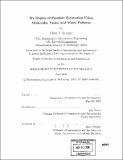| dc.contributor.advisor | Eric Feron. | en_US |
| dc.contributor.author | Tournier, Glenn P. (Glenn Paul) | en_US |
| dc.contributor.other | Massachusetts Institute of Technology. Dept. of Aeronautics and Astronautics. | en_US |
| dc.date.accessioned | 2007-07-18T13:14:23Z | |
| dc.date.available | 2007-07-18T13:14:23Z | |
| dc.date.copyright | 2006 | en_US |
| dc.date.issued | 2006 | en_US |
| dc.identifier.uri | http://hdl.handle.net/1721.1/37951 | |
| dc.description | Thesis (S.M.)--Massachusetts Institute of Technology, Dept. of Aeronautics and Astronautics, 2006. | en_US |
| dc.description | Includes bibliographical references (p. 105-107). | en_US |
| dc.description.abstract | We present the vision-based estimation of the position and orientation of an object using a single camera relative to a novel target that incorporates the use of moire patterns. The objective is to acquire the six degree of freedom estimation that is essential for the operation of vehicles in close proximity to other craft and landing platforms. A target contains markers to determine relative orientation and locate two sets of orthogonal moire patterns at two different frequencies. A camera is mounted on a small vehicle with the target in the field of view. An algorithm processes the images extracting the attitude and position information of the camera relative to the target utilizing geometry and 4 single-point discrete Fourier transforms (DFTs) on the moire patterns. Manual and autonomous movement tests are conducted to determine the accuracy of the system relative to ground truth locations obtained through an external indoor positioning system. Position estimations with accompanying control techniques have been implemented including hovering, static platform landings, and dynamic platform landings to display the algorithm's ability to provide accurate information to precisely control the vehicle. The results confirm the moire target system's feasibility as a viable option for low-cost relative navigation for indoor and outdoor operations including landing on static and dynamic surfaces. | en_US |
| dc.description.statementofresponsibility | by Glenn P. Tournier. | en_US |
| dc.format.extent | 107 p. | en_US |
| dc.language.iso | eng | en_US |
| dc.publisher | Massachusetts Institute of Technology | en_US |
| dc.rights | M.I.T. theses are protected by copyright. They may be viewed from this source for any purpose, but reproduction or distribution in any format is prohibited without written permission. See provided URL for inquiries about permission. | en_US |
| dc.rights.uri | http://dspace.mit.edu/handle/1721.1/7582 | |
| dc.subject | Aeronautics and Astronautics. | en_US |
| dc.title | Six degrees of freedom estimation using monocular vision and moiré patterns | en_US |
| dc.type | Thesis | en_US |
| dc.description.degree | S.M. | en_US |
| dc.contributor.department | Massachusetts Institute of Technology. Department of Aeronautics and Astronautics | |
| dc.identifier.oclc | 144589001 | en_US |
